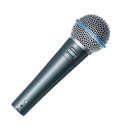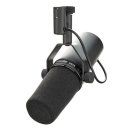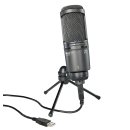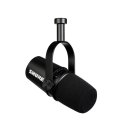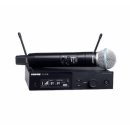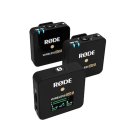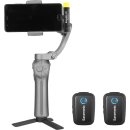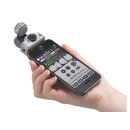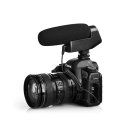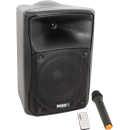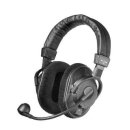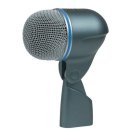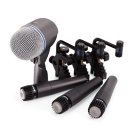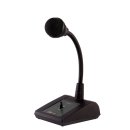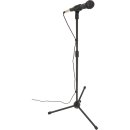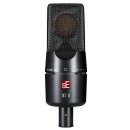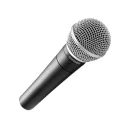Microphones
Find Your Perfect Microphone: A Comprehensive Collection
When it comes to capturing the perfect sound, having the right microphone can make all the difference. Whether you're a musician looking to record your latest masterpiece or a performer seeking the perfect stage mic, our comprehensive collection of microphones has got you covered. With a wide range of options to choose from, including condenser mics, dynamic mics, and ribbon mics, we've got everything you need to take your sound to the next level. So why settle for anything less than perfect? Browse our collection today and find your perfect microphone.
The importance of microphones
Microphones are one of the most essential tools in the music and audio industry. They are the primary means of capturing sound and converting it into an electrical signal, which can then be amplified, recorded, and manipulated. Whether you're recording in a studio, performing live on stage, or conducting a podcast, having the right microphone is crucial to achieving the highest quality sound.
For musicians, microphones are the key to capturing their music in the best possible way. A great microphone can bring out the nuances and subtleties of performance, adding depth and texture to the sound. Whether you're a singer, a guitar player, or a drummer, having the right microphone can make all the difference in how your music is heard and appreciated.
But it's not just musicians who rely on microphones. Audio professionals, such as sound engineers and producers, use microphones to capture and shape the sound for a variety of purposes. From recording voiceovers for commercials to capturing the sounds of nature for film, microphones are integral to the audio production process.
In addition to their importance in capturing sound, microphones also play a critical role in live sound reinforcement. A high-quality microphone can help a performer cut through the mix and be heard clearly by the audience. Whether you're singing, speaking, or playing an instrument, having the right microphone can help you connect with your audience and create a memorable performance.
In short, microphones are essential tools for anyone involved in music or audio production. They are the key to capturing and enhancing the sound, whether you're in the studio or on stage. With our comprehensive collection of microphones, we understand the importance of having the right tool for the job. That's why we offer a wide range of products, from high-end studio microphones to versatile live microphones, to suit any musician or audio professional's needs.
So why settle for mediocre sound when you can have exceptional sound quality with the right microphone? Browse our collection today and discover the perfect microphone for your needs. With our commitment to quality and attention to detail, you can trust us to provide you with the best possible audio experience.
Microphone technology-history lesson
The history of microphone technology dates back to the early 1800s when the first rudimentary microphones were invented. These early microphones used a diaphragm to convert sound waves into mechanical vibrations, which were then converted into electrical signals.
In the late 1800s, Alexander Graham Bell invented the first practical microphone, which used a carbon button to amplify sound waves. This technology revolutionized communications and paved the way for the modern telephone.
In the early 1900s, condenser microphones were invented, which used a thin metal diaphragm and a charged plate to convert sound waves into electrical signals. These microphones were much more sensitive than previous models and are still widely used today in recording studios and broadcasting.
In the mid-1900s, dynamic microphones were introduced, which used a coil and magnet to convert sound waves into electrical signals. These microphones were more rugged and durable than condenser microphones and are commonly used in live sound reinforcement.
In recent years, new technologies such as ribbon microphones and shotgun microphones have been developed, which offer unique advantages for certain applications. Despite the many advancements in microphone technology, the basic principles of converting sound waves into electrical signals remain the same.
If you take a look through twitch.tv and take a look at all of the people streaming, playing pc games, or console gaming, there are tons of different microphones used to live streaming. From the most expensive dynamic microphones to great USB alternatives, just standing neatly on their desktop and doing their job.
Types of Microphones
When it comes to microphones, there are several different types available, each with their own unique characteristics and advantages. These include dynamic, condenser, ribbon, and shotgun microphones, among others.
Whether you're recording vocals, instruments or capturing sound for video, there is a microphone type that will suit your needs. Let's take a closer look at each of these microphone types and their features.
Condenser microphones
Condenser microphones are a popular choice for recording vocals, and acoustic instruments, and capturing sound for video. They work by using a thin metal diaphragm and a charged plate to convert sound waves into electrical signals. This type of microphone is known for its high sensitivity and accuracy, making it a go-to choice for professional recording studios and broadcasting. They are also called recording microphones to some hardcore microphone enthusiasts.
Condenser microphones are typically more expensive than dynamic microphones and require an external power source, known as phantom power, to operate. This can be a drawback for some users, but the increased sensitivity and clarity of sound make it worth the investment.
There are two main types of condenser microphones: large diaphragm and small diaphragm.
- Large diaphragm condenser microphones are great for recording vocals and solo instruments, as they capture a wide range of frequencies and produce a warm, natural sound.
- Small diaphragm condenser microphones, on the other hand, are better suited for recording acoustic instruments, such as guitars and drums, as they have a higher frequency response and can capture more detail in the sound.
Overall, condenser microphones are a versatile and reliable choice for any recording or broadcasting needs. Their high sensitivity and accuracy make them a top choice for professionals in the music and entertainment industry.
Dynamic microphones
Dynamic microphones are a popular choice for live performances and recording loud instruments such as drums and electric guitars. They work by using a diaphragm that moves a coil within a magnetic field, converting sound waves into electrical signals. This type of microphone is known for its durability and ability to handle high sound pressure levels without distortion or feedback issues. They are probably the most used microphones in the radio business today.
Dynamic microphones are typically less expensive than condenser microphones and do not require an external power source (some do though), making them a more practical choice for musicians on a budget or those who need a microphone for live performances.
There are different types of dynamic microphones, including moving coil and ribbon microphones.
- Moving coil dynamic microphones are the most common type, and they have a simple design that makes them less fragile and more resistant to moisture and dust.
- Ribbon dynamic microphones, on the other hand, have a more delicate design but are known for their smooth and natural sound.
Overall, dynamic microphones are a reliable and practical choice for any musician or sound engineer who needs to capture loud and dynamic sound sources. Their durability, affordability, and ability to handle high sound pressure levels make them an essential tool for any live performance or recording session.
Ribbon microphones
Ribbon microphones are a type of dynamic microphone that is known for their unique sound and delicate design. They work by using a thin ribbon of metal that vibrates in response to sound waves, which then generates an electrical signal. The result is a natural, warm sound that is often favored by musicians and recording engineers alike.
One of the main benefits of ribbon microphones is their ability to capture detail and nuance in sound. They have a smooth, natural response that is well-suited for recording acoustic instruments, vocals, and even ambient sound. Due to their sensitivity, they can pick up even the slightest changes in sound, which can make them a valuable tool for capturing subtleties in a performance.
However, due to their delicate design, ribbon microphones require special care and handling. They are vulnerable to damage from moisture, dust, and handling, so they should be stored and transported carefully. Additionally, they require a specialized preamp that can supply them with the correct level of gain, which can add to the overall cost of using them.
Despite these challenges, ribbon microphones remain a popular choice for many musicians and sound engineers who value their unique sound and versatility. If you are looking for a microphone that can capture natural, detailed sound with warmth and character, a ribbon microphone may be a great choice for you.
Specialty microphones (e.g. lavalier, shotgun)
Specialty microphones, such as lavalier and shotgun microphones, offer unique features that can help capture sound in specific situations.
Lavalier microphones, also known as lapel microphones, are small and discreet, making them a popular choice for interviews, presentations, and live performances. They can be clipped onto clothing or hidden in hair or accessories, allowing the speaker to move freely while still capturing clear audio. Lavalier microphones are also often used in film and television production, where they can be placed on actors to capture dialogue with minimal interference.
Shotgun microphones, on the other hand, are highly directional and can capture sound from a distance. They are often used in film and television production, as well as for recording outdoor events such as sports games or concerts. Shotgun microphones are designed to reject sound from the sides and rear, making them ideal for picking up sound from a specific direction while minimizing background noise. At the same time, they are very robust and will live longer than a typical microphone.
Other specialty microphones include boundary microphones, which can be placed on a flat surface to capture sound from a wide area, and headset microphones, which are commonly used by performers who need their hands free.
While specialty microphones may not be as versatile as more general-purpose microphones like dynamic or condenser microphones, they are essential tools for specific situations where their unique features can make all the difference. Whether you're a filmmaker, presenter, or performer, there is sure to be a specialty microphone that can help you capture high-quality audio in
Microphone Applications
Microphones are essential tools for capturing sound in a variety of applications. From recording music in the studio to amplifying a singer's voice on stage, there are many different types of microphones that are designed for specific applications. Understanding the different microphone applications can help you choose the right microphone for your needs and ensure that you get the best possible sound quality. Whether you're a musician, podcaster, or filmmaker, there is a microphone out there that is perfect for your needs.
Recording vocals
Recording vocals is an essential part of music production, and having the right microphone can make all the difference in capturing high-quality audio. When choosing a microphone for recording vocals, there are a few factors to consider.
First and foremost, you'll want to consider the type of microphone. Condenser microphones are often preferred for recording vocals, as they are highly sensitive and can capture the nuances of a singer's voice. Dynamic microphones are also a popular choice, as they are more rugged and can handle high sound pressure levels without distortion.
You'll also want to consider the polar pattern of the microphone. Cardioid microphones are a common choice for recording vocals, as they pick up sound from the front while rejecting sound from the back and sides. This helps to minimize background noise and ensure that the focus is on the vocalist.
Another factor to consider is the frequency response of the microphone. Some microphones are designed to emphasize certain frequencies, such as the high frequencies of a singer's voice. Others have a more balanced response, which can be useful for recording a wide range of instruments and vocals.
Ultimately, the best microphone for recording vocals will depend on your specific needs and preferences. It's important to do your research and try out different microphones before making a decision. With the right microphone and some careful placement and settings, you can capture stunning vocal recordings that will stand out in any mix.
Recording instruments
When it comes to recording instruments, having the right microphone can make all the difference in capturing the true essence of the sound. Whether you're recording a guitar, piano, or drums, there are a few factors to consider when choosing a microphone.
Firstly, you'll want to consider the type of microphone. Dynamic microphones are often a popular choice for recording instruments, as they can handle high sound pressure levels and are less sensitive to background noise. However, condenser microphones can also be a great choice, especially when capturing the subtleties of acoustic instruments.
Next, you'll want to consider the polar pattern of the microphone. For instruments that have a single direction of sound, such as a guitar, a unidirectional microphone like a cardioid or super-cardioid can be a good choice. However, for instruments that have sound emanating from multiple directions, like a drum set, an omnidirectional microphone may be more appropriate.
Additionally, the frequency response of the microphone is important to consider. Some microphones are designed to capture certain frequencies, while others may have a more balanced response. It's important to choose a microphone that accurately captures the specific sound of the instrument you're recording.
Finally, the placement of the microphone is crucial. The placement will affect the tone and balance of the instrument's sound. Experimenting with different mic positions can help you achieve the desired sound for your recording.
Ultimately, choosing the right microphone for recording instruments will depend on the type of instrument, the environment, and the desired sound. With our comprehensive collection of microphones, we have options for every type of instrument and recording situation. From dynamic to condenser, uni-directional to omnidirectional, and everything in between, our range of microphones will help you capture the perfect sound for your next recording project. Trust in our expertise and attention to detail to help you find the perfect microphone to suit your specific needs and preferences. Don't settle for anything less than the best when it comes to capturing the true essence of your music.
Live performances
Microphones are essential for any musician performing live, whether it's a solo act or a full band. The right microphone can make a huge difference in the quality of the sound, ensuring that every note, every word, and every nuance is heard by the audience.
One of the most important factors to consider when choosing a microphone for live performances is the type of microphone. Dynamic microphones are often the go-to choice for live performances, as they can handle high sound pressure levels and are less sensitive to feedback. However, condenser microphones can also be a great option, especially for capturing the subtleties of vocals or acoustic instruments.
Another important consideration is the polar pattern of the microphone. For solo performers or vocalists, a cardioid or super-cardioid microphone can help to isolate the sound and minimize background noise. On the other hand, for bands or ensembles, an omnidirectional microphone may be more appropriate to capture the full sound of the group.
The quality of the microphone is also crucial for live performances, as it can affect the clarity and fidelity of the sound. A high-quality microphone can help to ensure that the sound is clear and balanced, even in a noisy or crowded environment.
Ultimately, choosing the right microphone for live performances will depend on the specific needs of the musician or group. With our extensive range of microphones, we have options for every type of performer and performance setting.
Broadcast and podcasting
When it comes to broadcasting and podcasting, the quality of the microphone is paramount. Whether you're recording a radio show, a podcast, or a voiceover, a high-quality microphone is essential to capture the nuances of the voice and ensure that the message comes across loud and clear.
At our store, we offer a wide variety of microphones specifically designed for broadcasting and podcasting. From dynamic to condenser, and from USB to XLR, we have options to suit every need and preference.
One of the most important factors to consider when choosing a microphone for broadcasting or podcasting is its sensitivity. A condenser microphone is often the preferred choice, as it is more sensitive and can capture a wider range of frequencies. However, a dynamic microphone can also be a great option, especially if you're recording in a noisy environment or have a lot of background noise to contend with.
Another important consideration is the polar pattern of the microphone. For solo recordings or interviews, a cardioid or super-cardioid microphone can help to isolate the sound and minimize ambient noise. However, for recording a group discussion or a roundtable, an omnidirectional microphone may be more appropriate to capture the full sound of the group.
When it comes to broadcasting and podcasting, the quality of the microphone is crucial. A high-quality microphone can help to ensure that the sound is clear, balanced, and free from background noise. With our extensive range of microphones, you can be sure to find the perfect microphone here at SoundStoreXL.
Video production
In the world of video production, having high-quality audio is just as important as having stunning visuals. A good microphone can make all the difference in capturing clear and crisp audio that complements your video content.
At SoundStoreXL, we offer a wide range of microphones specifically designed for video production. Whether you're filming a documentary, a music video, or a corporate video, we have the perfect microphone to suit your needs.
One important consideration when choosing a microphone for video production is its directional capabilities. A directional microphone, such as a shotgun microphone, is ideal for capturing sound from a specific source while minimizing background noise. This can be especially useful for interviews or capturing dialogue in noisy environments.
Another consideration is the microphone's frequency response. A microphone with a flat frequency response will capture a wide range of frequencies, making it a versatile option for many different types of video production. Alternatively, a microphone with a boosted high-end response can help to capture the subtle nuances of music or sound effects.
We also offer a range of wireless microphones, which can be particularly useful for capturing audio in situations where a wired microphone would be impractical. Our wireless microphones offer reliable and high-quality sound, with a range of up to 300 feet.
In short, a high-quality microphone can make all the difference in capturing clear and professional audio for your video production. With our extensive range of microphones, you can be sure to find the perfect microphone to suit your specific needs here at SoundStoreXL.
Microphone Features
Microphones come in all shapes and sizes, each designed with unique features to cater to different needs. Whether you're a musician, podcaster, or filmmaker, understanding microphone features is essential in selecting the right one for your specific purpose. In this section, we will explore some of the key features to consider when choosing a microphone, including directional capabilities, frequency response, and wireless connectivity.
Polar patterns (e.g. cardioid, omnidirectional)
One of the most important features to consider when choosing a microphone is its polar pattern. A polar pattern refers to the directional sensitivity of a microphone, or how it captures sound from different directions. There are several types of polar patterns available, each with its own unique advantages and disadvantages.
Cardioid pattern
Cardioid pattern microphones are often used in live performance and recording settings. Cardioid microphones are designed to capture sound from the front while rejecting sound from the sides and rear. This makes them ideal for isolating a particular sound source, such as a singer or instrument, while minimizing background noise.
Omnidirectional pattern
The omnidirectional pattern, captures sound from all directions equally. This makes them ideal for recording ambient sound or capturing a group of people or instruments in an open space.
Figure-eight pattern
There are also more specialized polar patterns, such as the figure-eight pattern which captures sound from the front and rear while rejecting sound from the sides. This can be useful for capturing sound from two sources simultaneously, such as a conversation between two people.
Ultimately, the choice of polar pattern will depend on the specific needs of the recording or performance.
At SoundStoreXL, we offer a wide range of microphones with different polar patterns to suit your needs. Whether you need a cardioid microphone for live performance or an omnidirectional microphone for recording ambient sound, we have the perfect microphone for you.
Frequency response
Frequency response is another crucial feature to consider when selecting a microphone. It refers to the range of frequencies that a microphone can accurately capture. The frequency response of a microphone is typically measured in hertz (Hz) and depicted on a graph, which shows the microphone's sensitivity to different frequencies.
The frequency response of a microphone can have a significant impact on the sound quality of a recording or performance. For example, if a microphone has a flat frequency response, it will capture sound accurately across the entire frequency range. However, if a microphone has a boosted or cut frequency response in certain frequency ranges, it can result in a colored or distorted sound.
When selecting a microphone, it's important to consider the frequency response that best suits your needs. For instance, if you're recording vocals, you may want a microphone with a frequency response that emphasizes the mid-range frequencies to help bring out the warmth and clarity of the voice. On the other hand, if you're recording drums, you may want a microphone with a frequency response that emphasizes the low-end frequencies to capture the punch and power of the drums.
Sensitivity
Microphone sensitivity is a crucial factor to consider when selecting a microphone for your recording or performance needs. Sensitivity refers to the microphone's ability to pick up sound and convert it into an electrical signal. A highly sensitive microphone will pick up even the slightest sounds, while a less sensitive microphone will require a louder sound source to produce an electrical signal.
The importance of microphone sensitivity depends on the specific application. For example, if you're recording subtle acoustic guitar performances or delicate vocal harmonies, you'll want a microphone with high sensitivity to capture all the nuances of the sound. On the other hand, if you're recording loud rock drums or electric guitar amps, a less sensitive microphone may be more appropriate to prevent distortion.
Impedance
Impedance is an important consideration when selecting a microphone for your recording or performance needs. Impedance refers to the electrical resistance of the microphone's output signal. It is typically measured in ohms and can have a significant impact on the sound quality of your recordings or performances.
The impedance of a microphone is important because it can affect the way the microphone interacts with the other components of your recording or performance setup. For example, if the impedance of your microphone is too high, it can cause problems when connecting to other equipment, such as mixers or amplifiers. On the other hand, if the impedance is too low, it can result in a loss of signal strength and a reduction in overall sound quality.
When selecting a microphone, it's important to consider the impedance that is appropriate for your specific application. For instance, if you're recording in a studio environment, you may want a microphone with a low impedance to ensure that you can easily connect it to your recording equipment. Alternatively, if you're performing live on stage, you may want a microphone with a high impedance to help reduce interference from other sources.
Overall, impedance is an important factor to consider when selecting a microphone, and choosing a microphone with the right impedance can help ensure that you achieve the best possible sound quality for your recordings or performances.
Connector type
There are different types of connectors available for microphones, each with their own benefits and drawbacks. The most common connector types are XLR and 1/4 inch.
XLR connectors are the industry standard for professional audio equipment. They have three pins and are designed to provide a balanced signal, which reduces interference and noise. They are sturdy and reliable, making them a popular choice for studio and live performance settings. However, they typically require a preamp or other specialized equipment to work properly.
1/4 inch connectors, also known as phone jacks, are commonly used in consumer audio equipment. They have a mono signal, which means they only have two connections. They are easy to use and widely available, but can be susceptible to interference and noise.
Other connector types include USB and TRRS (tip-ring-ring-sleeve). USB microphones are designed to plug directly into a computer and are popular for podcasting and home recording. TRRS connectors are commonly used with smartphones and other mobile devices, allowing you to record audio on the go.
When selecting a microphone, it's important to consider the connector type and ensure it is compatible with your equipment. Choosing the right connector type can help ensure a reliable connection and high-quality audio signal.
Note: be sure the microphone you are looking at, can connect to the target you have in mind. Whether it is a mac, pc, or a mixer, be sure before you buy.
Microphone Accessories
In addition to selecting the right microphone, there are a variety of accessories that can enhance the quality and usability of your microphone.
From stands and pop filters to shock mounts and windscreens, these accessories can help you achieve the best possible sound for your recordings or live performances. In this section, we will explore some of the most popular microphone accessories and their benefits.
Stands
Microphone stands are essential for any musician or recording artist. They provide stability and support for your microphone, allowing you to position it in the optimal location for recording or performance.
There are several types of microphone stands available, including tripod stands, boom stands, and desk stands. Tripod stands are the most common and provide a stable base for your microphone. Boom stands are ideal for recording or performing while standing, as they allow you to adjust the height and position of the microphone. Desk stands are a great option for podcasters or home recording enthusiasts, as they can be easily positioned on a desk or table.
When selecting a microphone stand, it's important to consider the weight and size of your microphone, as well as the environment in which you will be using it. If you plan to use your microphone stand for live performances, you'll want to choose a sturdy and durable stand that can withstand the rigors of the road. If you'll be using your stand in a studio or home recording environment, you may want to choose a stand that is adjustable and easy to position for optimal recording.
Overall, a high-quality microphone stand is an essential accessory for any musician or recording artist. It not only provides stability and support for your microphone but also allows you to achieve the best possible sound quality for your recordings or performances.
Shock mounts
Microphone shock mounts are another important accessory that can help improve the quality of your recordings. These mounts are designed to isolate your microphone from vibrations and shock, which can often be picked up during recordings or live performances.
A shock mount typically consists of a suspension system that holds your microphone securely in place, while also absorbing any vibrations or movements. This can result in a cleaner and more professional sound, especially when recording in noisy or turbulent environments.
There are several types of shock mounts available, including elastic bands and rubber suspensions. Some shock mounts are designed specifically for certain types of microphones, while others are more universal and can be used with a variety of different models. When selecting a shock mount, it's important to choose one that is compatible with your microphone and can provide the level of isolation and support that you need.
Overall, a high-quality shock mount can make a big difference in the quality of your recordings or live performances. By reducing unwanted vibrations and movements, you can achieve a cleaner and more professional sound that will impress your audience and capture the essence of your music.
Pop filters
Microphone pop filters, also known as windscreen filters, are another important accessory to consider when recording or performing music. These filters are designed to reduce or eliminate popping sounds that can occur when certain consonants, such as "p" and "b," are pronounced into the microphone.
A pop filter typically consists of a thin, mesh-like material that is placed in front of the microphone to absorb and diffuse the airflow from the speaker's breath. This can help to prevent the popping sounds that are often picked up by microphones, especially during close-up or high-volume recordings.
There are several types of pop filters available, including foam, metal, and fabric filters. Some filt



